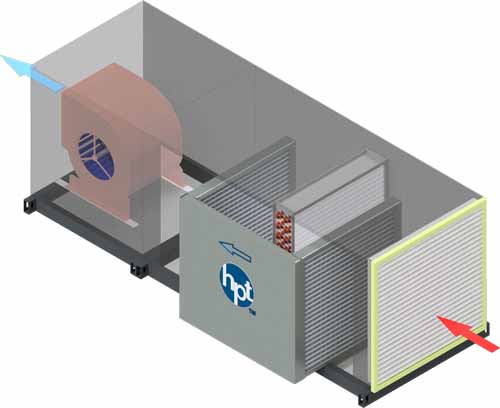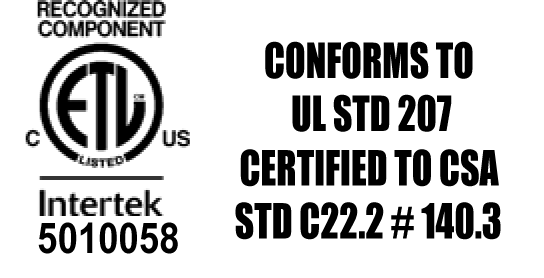Wrap around dehumidifier heat pipes are passive devices intended for use in air conditioning equipment to enhance dehumidification, reduce load on A/C equipment, and reduce or eliminate reheat. Each system is comprised of two modules; the first Heat Pipe module precools the entering air before it goes through the cooling coil. The precooled air then approaches the cooling coil at a lower temperature, thus lowering the load on the cooling coil or force a lower dew point. The cooling coil cools the air further before being reheated by the second Heat Pipe module. The function of the Heat Pipe is performed passively without any mechanical moving parts. The Heat Pipe is activated by the temperature difference between the air entering the precool Heat Pipe and the air leaving the cooling coil.
Increase Moisture Removal and Humidity Control
The first module of the wrap-around Heat Pipe precools the entering air. This causes the approach temperature of the air to the cooling coil to be lower. If the cooling coil works at same capacity, the air leaves the cooling coil will be colder with a lower dew point and a lower absolute humidity ratio. That means more moisture will be removed from air. Part of the cooling coil sensible capacity is converted into extra latent capacity.
Capacity Control
Heat pipe performance is driven by temperature differential between entering air and air leaving the cooling coil. As such precool and reheat can vary with ambient condition. To control heat pipe output at peak load or optimize performance at part load, valves are installed on individual circuits which are grouped in stages to turn them on or off based on load requirements I the space.
Dryer Supply Ducts
After leaving the cooling coil, the air is reheated by the second Heat Pipe module. This lowers the relative humidity ratio of the supply air. If the relative humidity ratio in occupied spaces and low velocity ducts and plenums exceeds 70%, fungal contamination (for example, mold, mildew, etc.) may occur. HPT Dehumidifier Heat Pipes help solve this problem
Savings Through Passive Reheat
Since Heat Pipes provide reheat by utilizing the heat from the entering air, reheat requirement for humidity control is reduced or totally eliminated? The additional cooling needed to compensate for the reheat is also provided passively by the first Heat Pipe module as it extracts heat from the entering air. Using Heat Pipes to replace active reheat results in substantial savings.
Savings Through Load Reduction and Equipment Downsizing
To cope with high humidity loads, the most frequently used technique is to oversize the A/C unit and then reheat the overcooled air. This results in high operating costs as well as initial equipment cost. With a chilled water system, HPT Heat Pipes allow the designer not only to reduce the size of the cooling coil but also to reduce the chilled water requirement. Thus, a smaller chiller unit can be used.
This Product is Ideal for:
Healthcare Facilities
![]()
Educational Facilities
Hospitality
Manufacturing
Sports Facilities
Let Our Zero Cross-Contamination Energy Recovery Solutions Help Your Bottom Line.


All HPT's Heat Pipe Products are ETL Certified


